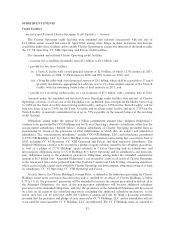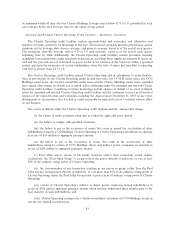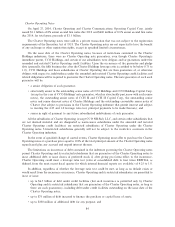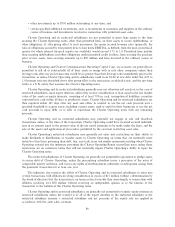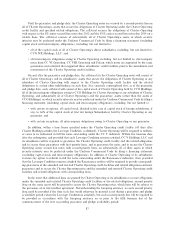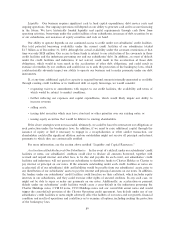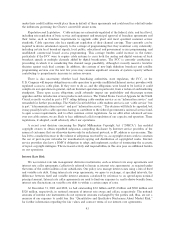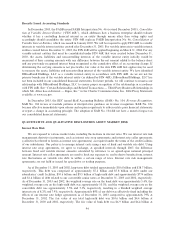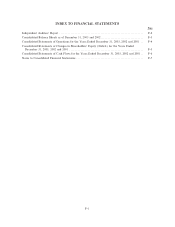Charter 2003 Annual Report Download - page 93
Download and view the complete annual report
Please find page 93 of the 2003 Charter annual report below. You can navigate through the pages in the report by either clicking on the pages listed below, or by using the keyword search tool below to find specific information within the annual report.to these proceedings, could result in substantial costs, substantial potential liabilities and the diversion of
management's attention, and could adversely aÅect our ability to execute our business and Ñnancial strategies.
Competition. The industry in which we operate is highly competitive. In some instances, we compete
against companies with fewer regulatory burdens, easier access to Ñnancing, greater personnel resources,
greater brand name recognition and long-established relationships with regulatory authorities and customers.
Increasing consolidation in the cable industry and the repeal of certain ownership rules may provide additional
beneÑts to certain of our competitors, either through access to Ñnancing, resources or eÇciencies of scale.
Our principal competitor for video services throughout our territory is direct broadcast satellite television
services, also known as DBS. Competition from DBS, including intensive marketing eÅorts and aggressive
pricing, has had an adverse impact on our ability to retain customers. Local telephone companies and electric
utilities can compete in this area, and they increasingly may do so in the future. The subscription television
industry also faces competition from free broadcast television and from other communications and entertain-
ment media. With respect to our Internet access services, we face competition, including intensive marketing
eÅorts and aggressive pricing, from telephone companies and other providers of ""dial-up'' and digital
subscriber line technology, also known as DSL. Further loss of customers to DBS or other alternative video
and data services could have a material negative impact on our business.
Mergers, joint ventures and alliances among franchised, wireless or private cable operators, satellite
television providers, local exchange carriers and others, and the repeal of certain ownership rules may provide
additional beneÑts to some of our competitors, either through access to Ñnancing, resources or eÇciencies of
scale, or the ability to provide multiple services in direct competition with us.
Variable Interest Rates. At December 31, 2003, excluding the eÅects of hedging, approximately 39% of
our debt bears interest at variable rates that are linked to short-term interest rates. In addition, a signiÑcant
portion of our existing debt, assumed debt or debt we might arrange in the future will bear interest at variable
rates. If interest rates rise, our costs relative to those obligations will also rise. As of December 31, 2003 and
December 31, 2002, the weighted average interest rate on the bank debt was approximately 5.4%, respectively,
the weighted average interest rate on the high-yield debt was approximately 10.3%, and the weighted average
interest rate on the convertible debt was approximately 5.5% and 5.3%, respectively, resulting in a blended
weighted average interest rate of 8.2% and 7.9%, respectively. Approximately 80% of our debt was eÅectively
Ñxed including the eÅects of our interest rate hedge agreements as of December 31, 2003 compared to
approximately 79% at December 31, 2002.
Streamlining of Operations. In the past, we experienced rapid growth from acquisitions of a number of
smaller cable operators and the rapid rebuild and rollout of advanced services. Our future success will depend
in part on our ability to standardize and streamline our operations. The failure to implement a consistent
corporate culture and management, operating or Ñnancial systems or procedures necessary to standardize and
streamline our operations and eÅectively operate our enterprise could have a material adverse eÅect on our
business, results of operations and Ñnancial condition. In addition, our ability to properly manage our
operations will be impacted by our ability to attract, retain and incentivize experienced, qualiÑed, professional
management.
Services. We expect that a substantial portion of our near-term growth will be achieved through
revenues from high-speed data services, digital video, bundled service packages, and to a lesser extent various
commercial services that take advantage of cable's broadband capacity. The technology involved in our
product and service oÅerings generally requires that we have permission to use intellectual property and that
such property not infringe on rights claimed by others. We may not be able to oÅer these advanced services
successfully to our customers or provide adequate customer service and these advanced services may not
generate adequate revenues. Also, if the vendors we use for these services are not Ñnancially viable over time,
we may experience disruption of service and incur costs to Ñnd alternative vendors. In addition, if it is
determined that the product being utilized infringes on the rights of others, we may be sued or be precluded
from using the technology.
91



